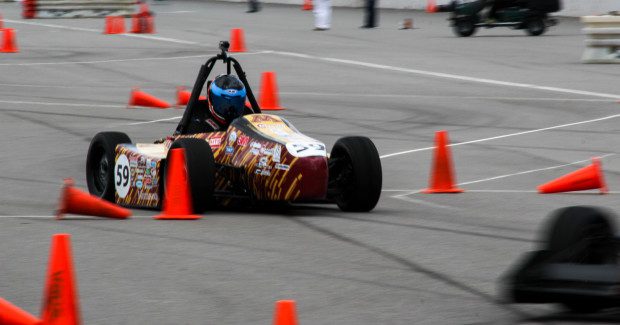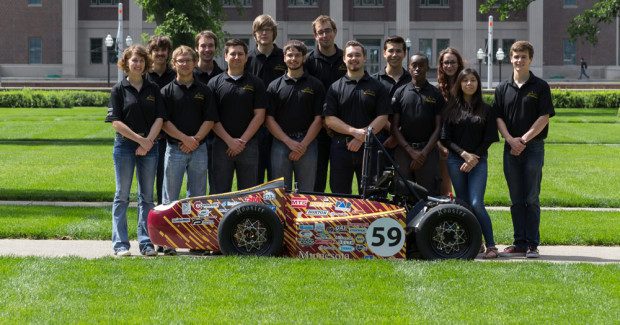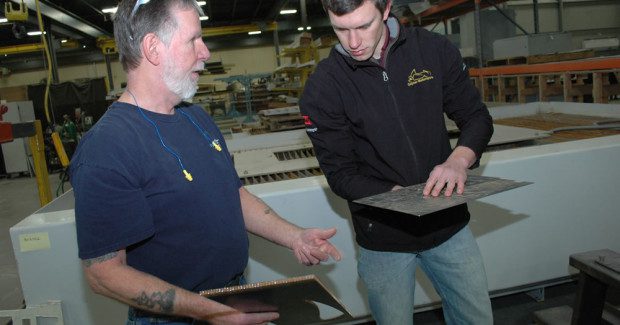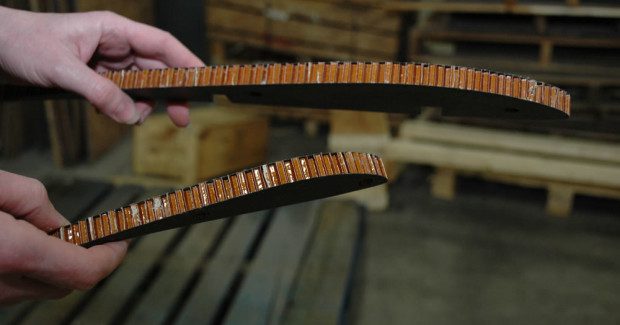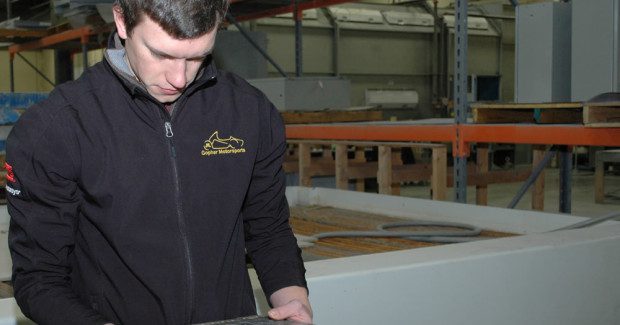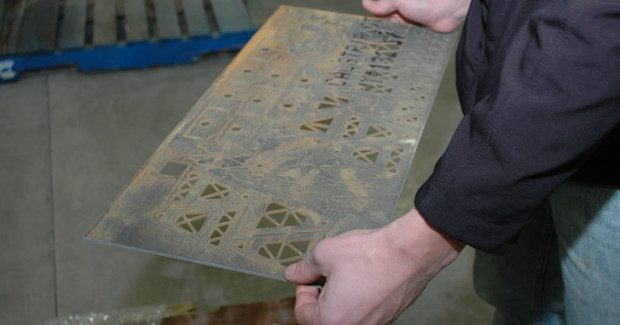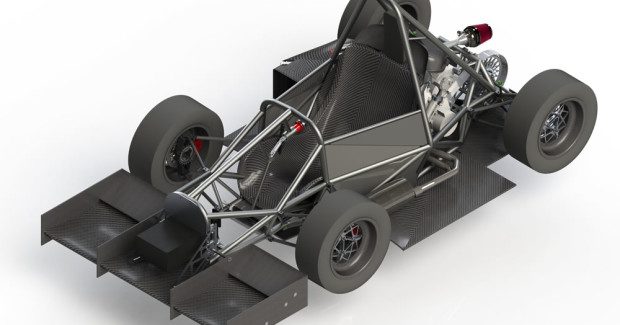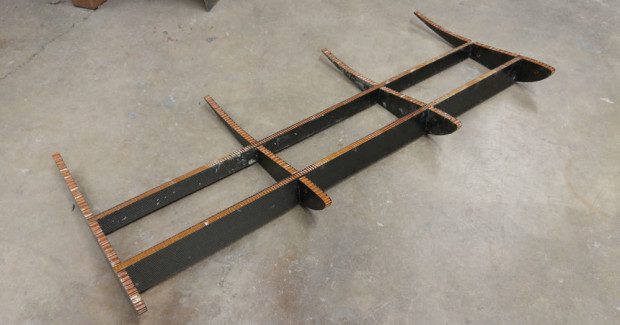Going for the Right Formula to Compete
Gopher Motorsports has enlisted Jet Edge to cut carbon composite, steel and aluminum parts for their Formula SAE race car using waterjet technology.
Posted: April 1, 2016
Determined to race its way to a Top 10 finish at the intensely competitive Michigan Formula SAE this May, the University of Minnesota’s Gopher Motorsports team has enlisted the help of waterjet manufacturer Jet Edge, Inc. (St. Michael, MN) to cut parts for the team’s #52 G04-16 Formula SAE race car.
Jet Edge has been busy waterjetting a wide range of carbon composite, steel and aluminum parts for the Gophers, who are building an open-wheeled, open cock-pit race car for the Society of Automotive Engineer’s largest and most prestigious global collegiate competition May 11-14 at Michigan International Speedway (MIS). Among the parts being waterjet are mounting tabs for the frame, structural inserts for the wings, and several other components, including the chain guard and brake rotors.
“Using waterjet is the fastest way to produce parts with the geometry that we’ve designed,” said Nathan Tigges, the Gopher Motorsports FSAE vice president (mechanical engineering/class of 2018). “Based upon our good experiences with waterjet cutting, we have redesigned several CNC parts to be manufactured as an assembly from waterjet parts, such as our rear bellcranks.”
The Formula SAE competition draws some of the world’s brightest engineering students, who design, manufacture, market, and ultimately race their cars at MIS, which is widely regarded as the fastest track in NASCAR. The teams are scored on their vehicle’s performance, business logic and design presentation. Gopher Motorsports, which is the University of Minnesota’s student chapter of the Society of Automotive Engineers, has been competing in the Formula SAE since 1997, twice placing seventh out of 120 teams from around the world.
Gopher Motorsports is 100 percent student led and is largely funded by industry sponsors. Each year the team develops, builds and tests a high performance highly-engineered race car to compete in the global Formula SAE Series. The competition’s goal is to design, manufacture, market, and race an open-wheel, open-cockpit, and single-seat vehicle marketable to the weekend autocrosser.
In 2015, the team placed 13th, but this year the Gophers have their sights set on a Top 10 finish and hope to continue outpacing their rivals from the University of Wisconsin-Madison. “We are proud to say we’ve beaten Madison for three years running!” Tigges said.
Gopher Motorsports builds a new car every year. They are required to change the frame geometry every year. To improve competitiveness, they also fully redesign about one-third of the system each year. Another one-third of the car needs to be revised in order to comply with the new designs and the legacy components. Prior to 2015, the team pillaged old cars for parts, but with the support of the university and local community, they are now able preserve the old models. This allows them to preserve the team’s heritage, train new drivers and give future team members the ability to see the progression of previous designs so they can improve upon them.
Tigges noted that Jet Edge has been very helpful in saving the students time, money and material, which should give the 34-member team an edge in the important “Cost Report” event at the Michigan competition. “We are able to produce high quality parts at low cost, both in monetary and personnel terms,” he said. “Having a great sponsor like them reduces the time we would otherwise spend in the shop ourselves, and lets us use money that otherwise would be spent on the same services elsewhere. That not only lets our members work on other projects, but also lets us stretch our budget. Using waterjet technologies improves our competitiveness, because it helps us reduce our estimated large-scale production cost in the ‘Cost Report’ event at competition. Rather than pricing these parts as machine parts, we are able to quote the cost of waterjet cutting, which drives down the overall budget in our Cost Report.”
Tigges added that working with Jet Edge’s team has been a great learning experience. “From working with them we have figured out ways to more efficiently utilize the raw materials that we have,” he noted. “Their machinist Brian Wallace helped us save half of a sheet of carbon composite material by nesting our pieces more efficiently, which really helps us out. More importantly, we will be able to implement some of those efficiencies to help out down the road!”
Wallace, who runs the company’s waterjet applications test lab, has been cutting the team’s parts on a premier EDGE X-5 5-axis CNC waterjet system that transforms ordinary tap water and garnet abrasive into a 75,000 psi hair-thin bullet-fast abrasive waterjet and cuts precise shaped parts from virtually any material. The system uses a hydraulic intensifier pump to pressurize the water, which is then forced through a jewel orifice, mixed with abrasive and focused through a nozzle. Wallace used a .010/.030 orifice/nozzle combination and 0.5 pounds per minute of 80 grit garnet abrasive to cut the Gophers’ parts.
The honor of driving the #52 at Michigan will go to the team’s fastest drivers, said Gopher Motorsports Team member Phil Hoff (mechanical engineering/class of 2016), who explained that the team determines its fastest drivers during actual behind the wheel time trials and by racing on a simulator that several of the team members built themselves.
Tigges noted that the team has made driver training a priority this year since both of the team’s drivers are graduating soon. “60 percent of our points come from dynamic events, so it is imperative that we have a strong supply of capable drivers,” he said. “It’s significantly harder to design a faster car than to train drivers to be faster.”
In addition to placing competitively in the Formula SAE, Gopher Motorsports has received several awards, including the Cummins Powertrain Excellence award. They were one of only 10 teams worldwide chosen by Bosch for sponsorship because of the creativity they displayed in testing when they lost critical dynamometer research space but compensated by building a dyno of their own along with trackside tuning.
Both Tigges and Hoff said that participating in Gopher Motorsports has been the highlight of their mechanical engineering education. “Working with Gopher Motorsports has given me several skills that I wouldn’t have gotten inside the classroom,” noted Tigges. “It is far and away the best supplement to my engineering education that I could hope for. Whether it’s working with sponsors, to coordinating complex schedules, or even analyzing performance over several years of design, the skills I’ve learned from being a part of this organization have been a great way to prepare for industry.”
Tigges said that the team participates in outreach events to inspire future engineering students, including the University of Minnesota’s State Fair booth, CSE Expo, STEM Expo, and other youth and high school events and visits. Gopher Motorsports planned to finish building their #52 race car by mid-March and to unveil it in April.
Jet Edge President Jude Lague said that he is very proud that they have had the opportunity to help Gopher Motorsports. “It’s always exciting to work with the talented engineering students at the University of Minnesota,” said Lague. “It’s no secret that we love racing. We’ll be cheering for Gopher Motorsports to win the Michigan Formula SAE, and I can’t wait to get behind the wheel on sponsor drive day.”
www.gophermotorsports.com, www.jetedge.com

